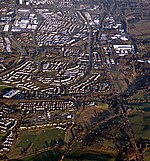Greenfaulds High School
Greenfaulds High School is a mixed, non-denominational six-year comprehensive secondary school. The original building was opened in 1971, while the new building was first opened to the public on 29 September 2016, and the old building has now been demolished. Greenfaulds is situated in the west of Cumbernauld and provides a service to the Greenfaulds, Ravenswood, Condorrat, Westfield, Eastfield, Balloch, Craigmarloch areas and parts of Seafar. The Head Teacher is James Vaugh-Sharp. The current school building has a maximum capacity of 1,450 pupils, making it the largest school in the Lanarskhire area and one of the largest in Scotland. Greenfaulds has six associated primary schools, which are Baird Memorial, Condorrat, Eastfield, Ravenswood, Westfield, and Woodlands.
Excerpt from the Wikipedia article Greenfaulds High School (License: CC BY-SA 3.0, Authors).Greenfaulds High School
Scott Crescent,
Geographical coordinates (GPS) Address Phone number Website External links Nearby Places Show on map
Geographical coordinates (GPS)
| Latitude | Longitude |
|---|---|
| N 55.9367 ° | E -4.00735 ° |
Address
Greenfaulds High School
Scott Crescent
G67 4AQ , Greenfaulds
Scotland, United Kingdom
Open on Google Maps








